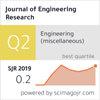利用神经模糊模型和机器学习算法,通过三个领域的学习数据预测学习者的学习成绩
IF 0.9
4区 工程技术
Q3 ENGINEERING, MULTIDISCIPLINARY
引用次数: 0
摘要
最近,学习者在学习编程课程时遇到了困难。本研究将通过翻转课堂、在线测验、边做边学和虚拟实验室等不同活动,帮助学习者快速学习复杂的概念。这项研究旨在解决学习者的困难,涵盖学习的所有领域,包括知识、技能和态度。最近,模糊逻辑方法被应用于教育领域,以克服这些限制。在采用模糊逻辑方法评价学生成绩时,对资格的评估是定性而非定量的。本研究在第一阶段应用模糊逻辑,在第二阶段应用因子分析(FA)和机器学习(ML)技术,以发现与信息技术课程学习者在学习管理系统(LMS)中有效使用主动学习策略(ALS)相关的基本因素。模糊逻辑和神经网络拓扑可通过 ANFIS(一种适应性网络)进行耦合。该研究利用模糊逻辑和神经网络拓扑结构将 ANFIS(一种自适应网络)耦合在一起,以找到学习者成功的关键因素。研究比较了五种监督机器学习算法的性能:K-Nearest Neighbor、决策树、Naive Bayes、判别分析和支持向量机。对这些分类器进行了评估,以确定它们在研究中的适用性和模型契合度。在本研究中,从信息技术本科生那里收集了实时数据。在 FA 分析之前,以下预测模型达到了较高的准确率:Naive Bayes (90 %)、支持向量机 (89%)、判别分析 (88%)、决策树 (86 %) 和 K-Nearest Neighbors (82%)。Naive Bayes 的准确率最高,为 90%。在因子分析(FA)之后,各种分类器达到的准确率如下:Naive Bayes - 92 %,K-近邻 - 92 %,支持向量机 - 90 %,判别分析 - 89 %,决策树 - 88 %。其中,Naive Bayes 和 K-Nearest Neighbors 的准确率最高,达到 92%。本文章由计算机程序翻译,如有差异,请以英文原文为准。
Predicting academic performance of learners with the three domains of learning data using neuro-fuzzy model and machine learning algorithms
In recent days, learners faced difficulties learning programming courses. This research study will help the learners learn complex concepts quickly with different activities like flipped classrooms, online quizzes, learning by doing, and a virtual laboratory. This research is carried out to address the difficulties of learners and cover all the domains of learning, including knowledge, Skill, and Attitude. The fuzzy logic method has recently been applied in education to overcome these restrictions. While employing the fuzzy logic approach to evaluate student achievement, qualifications are assessed qualitatively rather than quantitatively. This research study applies Fuzzy Logic in the first stage, Factor Analysis (FA), and Machine Learning (ML) techniques in the second stage to discover essential factors associated with the effective use of Active Learning Strategies (ALS) in the Learning Management System (LMS) of information technology course learners. Fuzzy logic and neural network topology can be coupled using ANFIS, an adaptable network. FA is performed to find the critical factors for successful learners. The study compares the performance of five supervised machine learning algorithms: K-Nearest Neighbor, Decision Tree, Naive Bayes, Discriminant Analysis, and Support Vector Machine. These classifiers are evaluated to determine their suitability and model fit in the context of the research. In this study, real-time data is collected from B.Tech Information Technology learners. The following prediction models achieved high accuracy before FA analysis: Naive Bayes (90 %), Support Vector Machine (89 %), Discriminant Analysis (88 %), Decision Tree (86 %), and K-Nearest Neighbors (82 %). Naive Bayes gives the best accuracy, with 90 %. Following factor analysis (FA), the accuracy achieved by various classifiers is as follows: Naive Bayes - 92 %, K-Nearest Neighbors - 92 %, Support Vector Machine - 90 %, Discriminant Analysis - 89 %, and Decision Tree - 88 %. Among these, Naive Bayes and K-Nearest Neighbors exhibit the highest accuracy of 92 %.
求助全文
通过发布文献求助,成功后即可免费获取论文全文。
去求助
来源期刊

Journal of Engineering Research
ENGINEERING, MULTIDISCIPLINARY-
CiteScore
1.60
自引率
10.00%
发文量
181
审稿时长
20 weeks
期刊介绍:
Journal of Engineering Research (JER) is a international, peer reviewed journal which publishes full length original research papers, reviews, case studies related to all areas of Engineering such as: Civil, Mechanical, Industrial, Electrical, Computer, Chemical, Petroleum, Aerospace, Architectural, Biomedical, Coastal, Environmental, Marine & Ocean, Metallurgical & Materials, software, Surveying, Systems and Manufacturing Engineering. In particular, JER focuses on innovative approaches and methods that contribute to solving the environmental and manufacturing problems, which exist primarily in the Arabian Gulf region and the Middle East countries. Kuwait University used to publish the Journal "Kuwait Journal of Science and Engineering" (ISSN: 1024-8684), which included Science and Engineering articles since 1974. In 2011 the decision was taken to split KJSE into two independent Journals - "Journal of Engineering Research "(JER) and "Kuwait Journal of Science" (KJS).
 求助内容:
求助内容: 应助结果提醒方式:
应助结果提醒方式:


